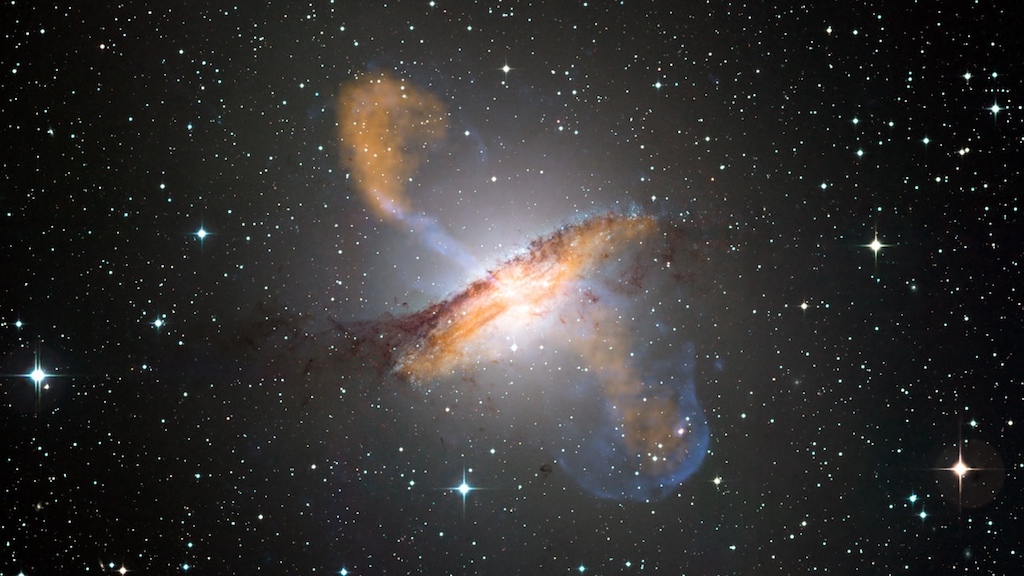Radio Telescopes Capture Best-Ever Snapshot of a Black Hole's Jets
Centaurus A is a giant elliptical active galaxy 12 million light years away. Radio and X-ray images reveal features associated with jets emanating from near the galaxy's central supermassive black hole, which has a mass of 55 million suns. Now, the TANAMI project has provided the best-ever view of these jets. In the radio image of the galaxy's core, the black hole is invisible but the jets show in great detail. Features as small as 15 light-days across can be resolved. The powerful jets feed vast lobes of radio-emitting gas that reach far beyond the visible galaxy.

Left: The giant elliptical galaxy NGC 5128 is the radio source known as Centaurus A. Vast radio-emitting lobes (shown as orange in this optical/radio composite) extend nearly a million light-years from the galaxy. Credit: Capella Observatory (optical), with radio data from Ilana Feain, Tim Cornwell, and Ron Ekers (CSIRO/ATNF), R. Morganti (ASTRON), and N. Junkes (MPIfR). Right: This radio image from the TANAMI project provides the sharpest-ever view of a supermassive black hole's jets. As seen here, the full extent of the jet and counterjet is 4.16 light-years, smaller than the distance between our sun and the nearest star. The image resolves details as small as 15 light-days across. Undetected between the jets is the galaxy's 55-million-solar-mass black hole. Credit: NASA/TANAMI/Müller et al.

No Labels. Left: The giant elliptical galaxy NGC 5128 is the radio source known as Centaurus A. Vast radio-emitting lobes (shown as orange in this optical/radio composite) extend nearly a million light-years from the galaxy. Credit: Capella Observatory (optical), with radio data from Ilana Feain, Tim Cornwell, and Ron Ekers (CSIRO/ATNF), R. Morganti (ASTRON), and N. Junkes (MPIfR). Right: This radio image from the TANAMI project provides the sharpest-ever view of a supermassive black hole's jets. As seen here, the full extent of the jet and counterjet is 4.16 light-years, smaller than the distance between our sun and the nearest star. The image resolves details as small as 15 light-days across. Undetected between the jets is the galaxy's 55-million-solar-mass black hole. Credit: NASA/TANAMI/Müller et al.

German Labels. Left: The giant elliptical galaxy NGC 5128 is the radio source known as Centaurus A. Vast radio-emitting lobes (shown as orange in this optical/radio composite) extend nearly a million light-years from the galaxy. Credit: Capella Observatory (optical), with radio data from Ilana Feain, Tim Cornwell, and Ron Ekers (CSIRO/ATNF), R. Morganti (ASTRON), and N. Junkes (MPIfR). Right: This radio image from the TANAMI project provides the sharpest-ever view of a supermassive black hole's jets. As seen here, the full extent of the jet and counterjet is 4.16 light-years, smaller than the distance between our sun and the nearest star. The image resolves details as small as 15 light-days across. Undetected between the jets is the galaxy's 55-million-solar-mass black hole. Credit: NASA/TANAMI/Müller et al.

The giant elliptical galaxy NGC 5128 is the radio source known as Centaurus A. Vast radio-emitting lobes (shown as orange in this optical/radio composite) extend nearly a million light-years from the galaxy. Credit: Capella Observatory (optical), with radio data from Ilana Feain, Tim Cornwell, and Ron Ekers (CSIRO/ATNF), R. Morganti (ASTRON), and N. Junkes (MPIfR).

The elliptical galaxy NGC 5128, host of the Centaurus A radio source, as it appears in visible light. The galaxy is located about 12 million light-years away and is one of the closest sporting an active supermassive black hole. Credit: Capella Observatory

This composite of visible, microwave (orange) and X-ray (blue) data reveals the jets and radio-emitting lobes emanating from Centaurus A's central black hole. Credit: ESO/WFI (visible); MPIfR/ESO/APEX/A.Weiss et al. (microwave); NASA/CXC/CfA/R.Kraft et al. (X-ray)

The TANAMI array consists of nine radio telescopes located on four continents. By combining data from the individual telescopes, astronomers can acquire images with the sharpness of a single telescope some 6,200 miles (10,000 km) across — about 80 percent of Earth's diameter. Credit: Matthias Kadler, Univ. of Würzburg
For More Information
Credits
Please give credit for this item to:
NASA/Goddard Space Flight Center. However, each image should be credited as indicated above.
-
Video editor
- Scott Wiessinger (UMBC)
-
Narrator
- Scott Wiessinger (UMBC)
-
Producer
- Scott Wiessinger (UMBC)
-
Science writer
- Francis Reddy (University of Maryland College Park)
-
Graphics
- Francis Reddy (University of Maryland College Park)
Release date
This page was originally published on Friday, May 20, 2011.
This page was last updated on Wednesday, May 3, 2023 at 1:53 PM EDT.
Series
This visualization can be found in the following series:Tapes
This visualization originally appeared on the following tapes:-
Best Ever view of Black Hole's Jets
(ID: 2011058)
Friday, May 20, 2011 at 4:00AM
Produced by - Robert Crippen (NASA)
